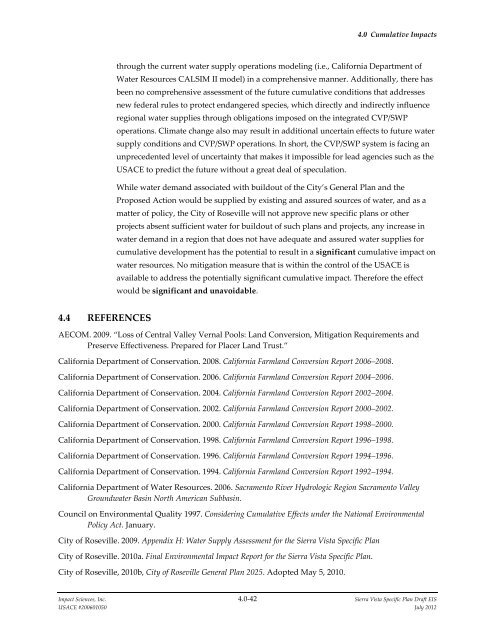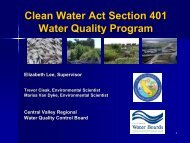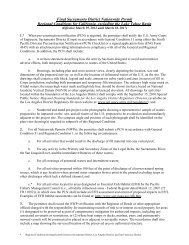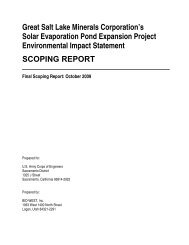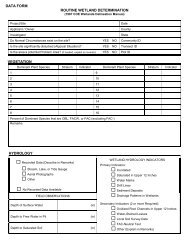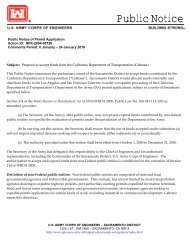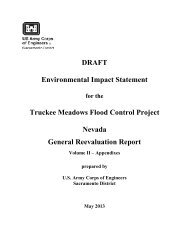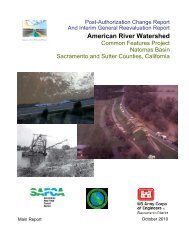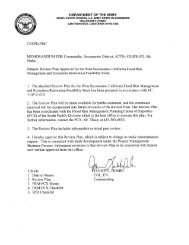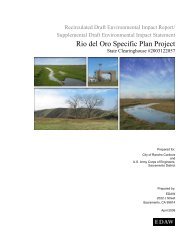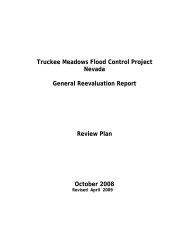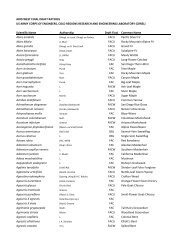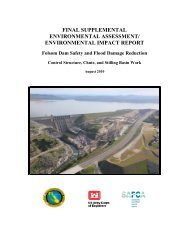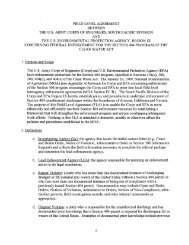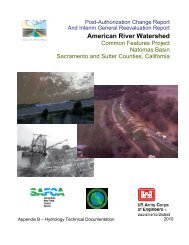4.0 CUMULATIVE IMPACTS - Sacramento District - U.S. Army
4.0 CUMULATIVE IMPACTS - Sacramento District - U.S. Army
4.0 CUMULATIVE IMPACTS - Sacramento District - U.S. Army
You also want an ePaper? Increase the reach of your titles
YUMPU automatically turns print PDFs into web optimized ePapers that Google loves.
<strong>4.0</strong> Cumulative Impacts<br />
through the current water supply operations modeling (i.e., California Department of<br />
Water Resources CALSIM II model) in a comprehensive manner. Additionally, there has<br />
been no comprehensive assessment of the future cumulative conditions that addresses<br />
new federal rules to protect endangered species, which directly and indirectly influence<br />
regional water supplies through obligations imposed on the integrated CVP/SWP<br />
operations. Climate change also may result in additional uncertain effects to future water<br />
supply conditions and CVP/SWP operations. In short, the CVP/SWP system is facing an<br />
unprecedented level of uncertainty that makes it impossible for lead agencies such as the<br />
USACE to predict the future without a great deal of speculation.<br />
While water demand associated with buildout of the City’s General Plan and the<br />
Proposed Action would be supplied by existing and assured sources of water, and as a<br />
matter of policy, the City of Roseville will not approve new specific plans or other<br />
projects absent sufficient water for buildout of such plans and projects, any increase in<br />
water demand in a region that does not have adequate and assured water supplies for<br />
cumulative development has the potential to result in a significant cumulative impact on<br />
water resources. No mitigation measure that is within the control of the USACE is<br />
available to address the potentially significant cumulative impact. Therefore the effect<br />
would be significant and unavoidable.<br />
4.4 REFERENCES<br />
AECOM. 2009. “Loss of Central Valley Vernal Pools: Land Conversion, Mitigation Requirements and<br />
Preserve Effectiveness. Prepared for Placer Land Trust.”<br />
California Department of Conservation. 2008. California Farmland Conversion Report 2006–2008.<br />
California Department of Conservation. 2006. California Farmland Conversion Report 2004–2006.<br />
California Department of Conservation. 2004. California Farmland Conversion Report 2002–2004.<br />
California Department of Conservation. 2002. California Farmland Conversion Report 2000–2002.<br />
California Department of Conservation. 2000. California Farmland Conversion Report 1998–2000.<br />
California Department of Conservation. 1998. California Farmland Conversion Report 1996–1998.<br />
California Department of Conservation. 1996. California Farmland Conversion Report 1994–1996.<br />
California Department of Conservation. 1994. California Farmland Conversion Report 1992–1994.<br />
California Department of Water Resources. 2006. <strong>Sacramento</strong> River Hydrologic Region <strong>Sacramento</strong> Valley<br />
Groundwater Basin North American Subbasin.<br />
Council on Environmental Quality 1997. Considering Cumulative Effects under the National Environmental<br />
Policy Act. January.<br />
City of Roseville. 2009. Appendix H: Water Supply Assessment for the Sierra Vista Specific Plan<br />
City of Roseville. 2010a. Final Environmental Impact Report for the Sierra Vista Specific Plan.<br />
City of Roseville, 2010b, City of Roseville General Plan 2025. Adopted May 5, 2010.<br />
Impact Sciences, Inc. <strong>4.0</strong>-42 Sierra Vista Specific Plan Draft EIS<br />
USACE #200601050 July 2012


